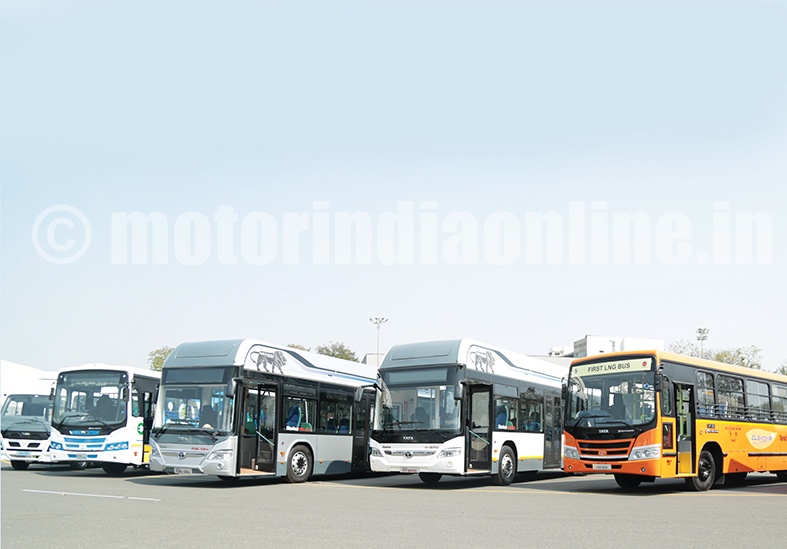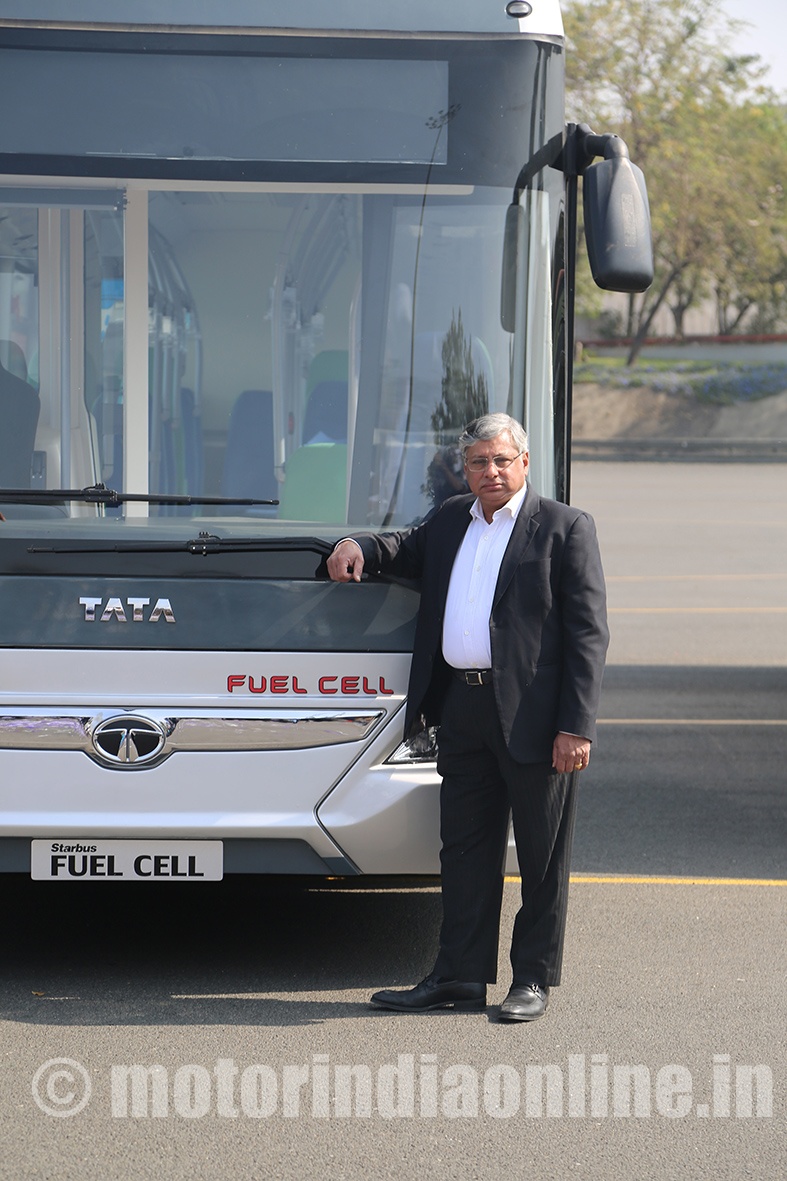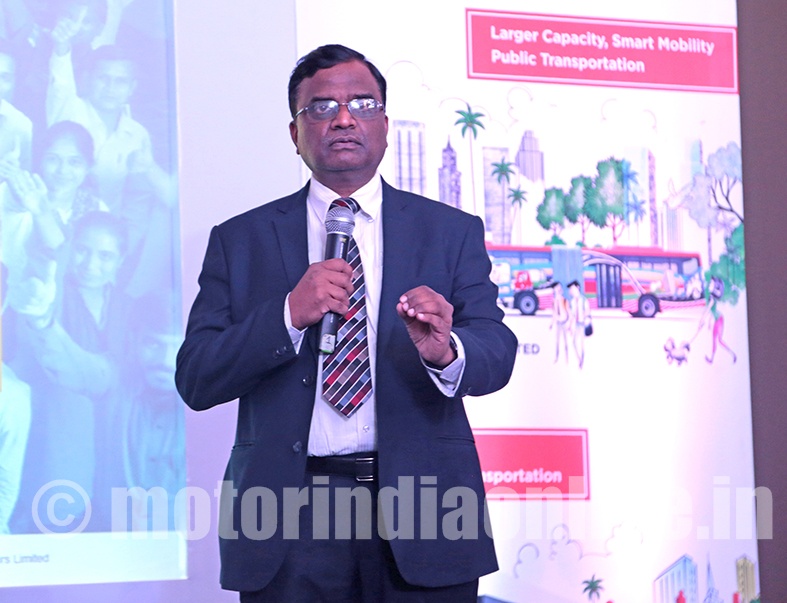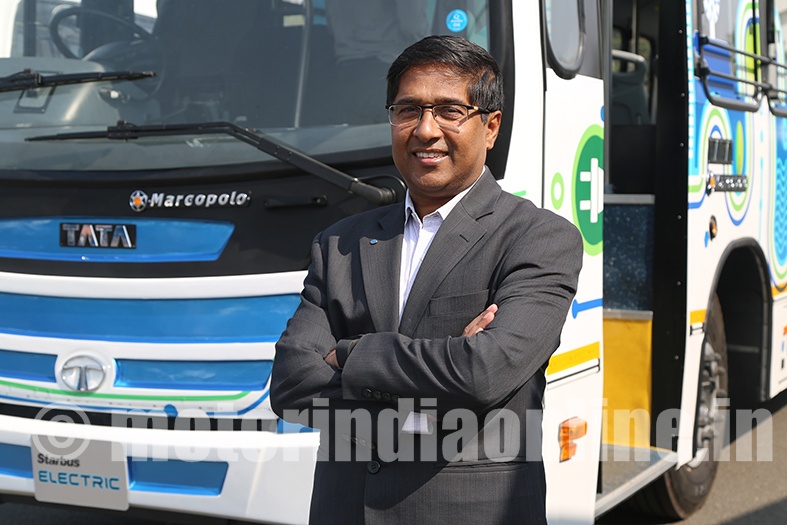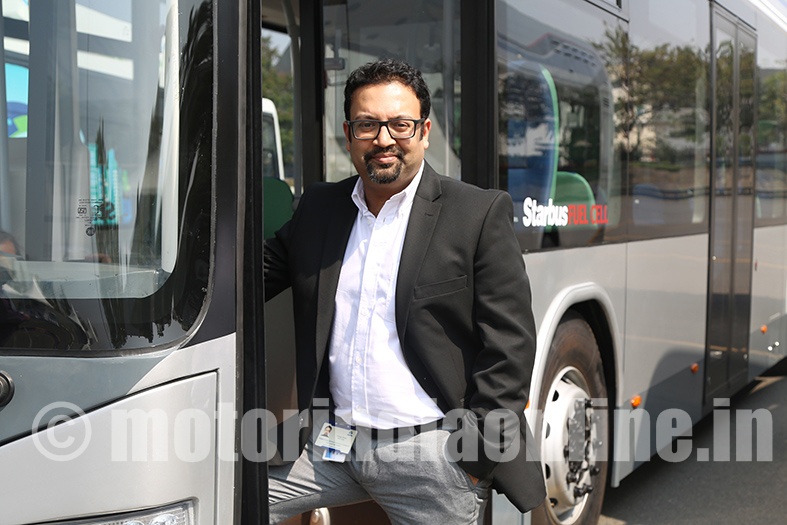Full electric, hybrid and LNG buses launched
As one of the country’s largest bus manufacturers, with the complete range of transit vehicles that meet every need, Tata Motors continued to be a leader in this segment not just by setting technological benchmarks but also by adapting innovations effectively to suit Indian travel conditions. People have witnessed in the past, a whole range of coach designs, from microbus, inter-city and touring coaches, luxurious inter-city travel options, to safe transport choices for school going children, Tata Motors is best suited to cater to customers’ needs with an entire gamut of day-to-day mass passenger transport solutions.
Now, pushing green technology in mass public transportation in India, Tata Motors unveiled a full electric bus and a hybrid bus, with indicative prices ranging between Rs. 1.6 crore and Rs. 2 crores. The company, which is leader in the commercial vehicles space in the country with a market share of around 55 per cent, also showcased its LNG-powered bus and an articulated bus. Besides, it also unveiled a bus with fuel cell technology and electric versions of its light commercial vehicles SuperAce, Magic and Magic Iris.
The line of buses displayed at the company’s Pune facility reiterated the OEMs’ commitment towards smart, green and futuristic mobility solutions. The electric bus was the Starbus electric with 9 m as well as 12 m length and the Starbus Hybrid, LNG and Fuel cell buses too boasted a 12m length. The articulated bus is 18m long. Developed indigenously, these buses are safe and comfortable and are economically viable ‘Made in India’ solutions.
Mr. Ravindra Pisharody, Executive Director – Commercial Vehicles, Tata Motors, said: “We are delighted to launch our new hybrid and electric buses today. At Tata Motors, our aim is to not only comply with emerging regulations of clean and green emission but also be ahead of the requirements. We have consistently been developing and manufacturing products that can contribute to CO2 reductions across all road transport segments, and with early investments in new technologies, we are geared up to further strengthen our market leadership.”
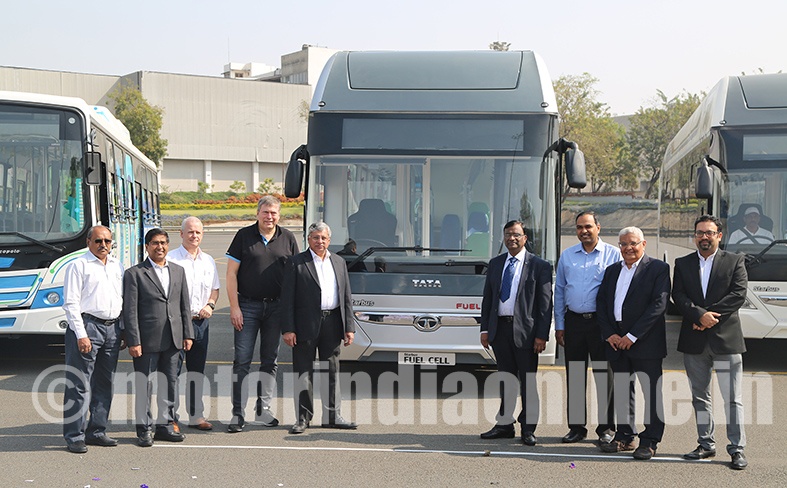
Tata Motors currently designs, develops and manufactures its buses in Pune, Dharwad, Pantnagar and Lucknow. Besides its partnership with ACGL of Goa for bus bodies, Tata Motors also has a joint venture with Marcopolo S.A. of Brazil, one of the largest bus body manufactures in the world, for fully built bus (FBV) solutions. Tata Motors’ approach of manufacturing FBVs (fully building vehicles), meets the Government’s new norms in terms of safety, fuel efficiency, wider bus gangways, with the flexibility to be powered by both CNG and diesel.
Primary motive, alternative fuels
Continuing its strategic quest in various segments, Tata Motors continues to actively participate in the development and implementation of solutions for mass passenger transport in the key markets across the world. Displaying the new series of buses, Tata Motors has given wide range of options to people. Considering different preferences by different cities it is catering ‘to each its own’ ideology. It is only this way that the company also will be able to strike a right balance towards sustainable growth and profitability. “We will work closely with government and regulatory authorities to intensify efforts at tackling pollution, focusing on building alternative transport fuels and infrastructure for smart cities of tomorrow,” emphasized Mr. Pisharody. Although the primary motive is to ease passenger movement in the smart cities, alternative fuels will enhance customer experience, make cities less polluted and roads congestion free. In the next few paragraphs let us go through each of the buses to understand what it takes to achieve these sustainable smart products.
Hybrid Electric Bus
Developed indigenously, the Starbus Hybrid Electric Bus is an economically viable, safe and environmentally friendly bus. Uniquely engineered for ease of operation, the Tata Starbus Diesel Series Hybrid Electric Bus uses diesel & electric in series hybrid mode, to propel the vehicle that complies with all UBS-II (Urban Bus Specifications), AIS 051 (Automotive Industry Standards) and CMVR (Central Motor Vehicle Rules). The vehicle works on an electric mode producing zero emissions, while the diesel mode is BS-4 compliant. The bus is based on a modular chassis, with electronically controlled air suspension systems (ECAS) at the front & rear, electronically controlled braking systems and an automatic transmission.
The Starbus Hybrid also uses new generation lithium ion phosphate batteries (Prismatic Cell) and can run without external charging infrastructures, due to integration of on-board charging, with energy storage. While the batteries are re-charged by running the Diesel powertrain, the system also regenerates braking energy through an advanced electronic braking system.
The technology thus makes adoption of such advanced buses hassle-free, without investing in high cost of charging stations at bus depots or en route, thereby giving operators the much-needed range and flexibility to shift bus routes as per demand and need. In certain driving modes, regenerative braking is used to capture lost energy and charge the battery.
The Tata Starbus Hybrid offers substantial improvement in fuel economy compared to a conventional bus. The buses series hybrid technology offers lowest cost of ownership, with improved fuel savings of 25-30 per cent and reduction in emissions in comparison to conventional buses. The bus also runs on pure electric mode, for around 30-35 per cent of the total travel distance.
A radical new transport option, the Starbus Hybrid Bus creates a win-win situation for all stakeholders. Transporters get the benefits of more passengers and a least polluting fleet vehicle, while commuters get a cost-effective transport choice, with increased comfort, safety and easy accessibility. “In Q1FY17-18 these buses are to be delivered to MMRDA, and connect railway stations in Mumbai like Sion, Bandra and Kurla to BKC. With electric mobility as a solution for the future, we are fully geared to cater to the huge potential arising for these technologies, right here in India,” beamed Mr. Pisharody.
Hydrogen Fuel-Cell Bus
Tata Motors first showcased the Starbus – Fuel Cell (Hydrogen) bus at Auto Expo 2012. A zero-emission transport solution for commuting within the city, the Starbus Fuel Cell Bus is an environment-friendly bus and is ideal for stop and go applications. Compared with battery-electric vehicles – which recharge their batteries by plugging in – the combination of fast, centralized refueling and longer driving ranges make fuel cells particularly appropriate for larger vehicles, with long-distance requirements, or for operations with lack of a plug- access.
In the Hydrogen Fuel-Cell bus, hydrogen is stored in a compressed form, combining with oxygen from the air to generate electricity, giving out water vapor as the only emission, a first by an Indian OEM. This technology makes bus travel completely clean and silent on road. However, like other electric vehicles (EVs), the Starbus Fuel Cell Bus employs idle-off, which shuts down the fuel cell at stop signs or in traffic.
With the MoU signed between Tata Motors and ISRO in 2006, ISRO has played an instrumental role by supporting Tata Motors with the rich technology in producing, storing and handling gaseous and liquid hydrogen. The team also helped generate technical specifications for all the elements and general specifications for the bus.
Ultra Electric Bus
The Ultra Electric Bus is available in two variants – 9m and 12m with semi-low floor (SLF) of 650mm. Built on the popular ULTRA platform, the Ultra Electric bus is based on the convenience of urban commuters. The vehicle dimensions and the seating capacity makes the Ultra Starbus Electric a perfect combination for staff, school and general city transportation. With a wide passage-way for free movement, wider window panes for better visibility along with SLF of 650mm, for safe and convenient transportation for commuters to enjoy public transportation, it also ensures fatigue-free driving with no clutch and gear shifting required.
These buses are fitted with CCTV cameras an Intelligence Transport Systems (ITS) for public information, through GPS via electronic destination display boards, indicating expected time of arrival at bus stops and route announcements within the bus. These buses also enhance operational efficiency for State Transport Units (STUs), with new generation Telematics for efficient and user friendly vehicle maintenance and tracking. Through this feature operators can also moderate and redesign the frequency of buses on every route.
Starbus LNG Bus
Tata Motors showcased the country’s first LNG bus, as an alternative to diesel and CNG power, providing benefits of lower carbon emissions and better fuel economy at the same time lowering operating costs, also significantly lowering emissions. Lighter in weight compared to buses powered by conventional fuels, Tata Motors’ LNG bus has enhanced levels of payload.
Moving towards gas power will not only contribute majorly towards decreasing emissions for a cleaner environment, but will also ensure better fuel efficiency, due to high energy density of LNG, providing for a longer range at more than 700km in one filling. LPG-powered vehicles also ensure better noise vibration harshness (NVH) characteristics for passenger comfort.
Articulated Bus
Tata Motors Articulated Bus (18m) is designed to carry more passengers (120+ versus 50-80), owing to the body design. This can in turn scale up PPHPD (passengers per hour per direction) without increased investments in infrastructure. The main benefits of an articulated bus over the standard bus are rapid simultaneous boarding and disembarkation through more and larger doors, much larger passenger capacity more efficient, less staff per bus hence higher revenue per bus. Wider doors provide ease of access for differently-abled passengers and the elderly.
Articulated buses are most suitable for the bus rapid transit system (BRTS) as they have higher capacity and can thus carry more passenger per hour per direction. Just as BRTS is future of mass transportation in India; articulated buses are future of BRTS.
‘We have a 3-horizon strategy for technology’
– Mr. Ravindra Pisharody, Executive Director – Commercial Vehicles, Tata Motors
MI: What message is Tata Motors giving to its customers, now that you have showcased, your full range of buses as well as future readiness? What does this mean to Tata Motors global ambitions?
Ravi Pisharody: Two Things, we have an order for the articulated buses and are supplying 30 buses to Hubli-Dharwad. Gujarat is also ordering a 900mm floor height BRTS buses, they have made it standard. Hubli-Dharwad is going to operate as a BRTS and if you see the concept it has a double door on both side, a lot of people can get in and get out at the same time. We are also going to fulfill our orders to MMRDA on the Starbus Hybrid Electric Bus. With these developments, we are trying to communicate that buses are our primary business and are fully focused on it. In the past, there have been criticism of Truck companies that they don’t make bus chassis but give truck chassis. We were the first company to start fully built buses. Now we have Tata Marcopolo in Dharwad and ACGL in Goa. The Hybrid is in ACGL and the Electric is in Marcopolo. These buses are export worthy. Actually, the Hybrid buses are already running in Madrid for the last 3 years. Therefore, we are less concerned about its exports potential. In India, we want to make a statement that we are a full range passenger transport player including Iris and Magic.
MI: Since the numbers of buses sold are just about 10 per cent of overall commercial vehicle sales, how do you strike a balance between future-readiness and profitability?
RP: It is challenging, but we invest Rs. 1,500-2,000 crores in future technologies. On the technology front we have a strategy that we call Horizons 1, 2 and 3. Horizon 1 is for the products which will need investment the same year like the electric and hybrid initiatives happening this year. Horizon 2 is for things which are needed two years down the year. Like BS-VI for 2020, which we know is coming. Horizon 3 relates to things where we invest looking at the future. They may happen or may not like fuel cells. We are unveiling it but whether we will get business from it even by 2025, nobody can guarantee. Electric, once in Horizon 3, moved to Horizon 2 and then Horizon 1 with investment requirement and we can promise you that by 17-18 it will be plying on roads with STUs. We work on these three things in terms of technology and try and see what can be put in the market, and then allocate budget for all of them.
‘Our strategic objective is to develop futuristic technologies’
– Dr. A.K. Jindal, Head – Engineering, Commercial Vehicles, Tata Motors
MI: At what level are the discussions with State Governments on setting up charging infrastructure for electric buses?
AK Jindal: We will work with our customers, for the initial testing. We will support them from our side. Infrastructure is not our job, we may support the Government, as wherever the budget for electric vehicle is sanctioned the cost of the infrastructure is also included. So, the operators will also set-up the charging station, whoever and wherever they decide to operate. We can help them by defining the specifications and facilitate in the right direction to set up charging point. STU’s will have to set up a minimum 440 volt supply station for charging and protect it from different weather conditions.
MI: How do you see the capabilities of battery development in India?
AKJ: It is very difficult to develop a cell manufacturing factory in India, what at best can happen is developing packs. We ourselves have gone into developing packs for ourselves but not the cell. So, we do not restrict ourselves to one technology. Tomorrow if there is something we can buy a new thing from somebody else.
MI: What will be the cost difference if we manufacture here in India? Is it the scale or know how that we lack?
AKJ: If we do manufacture packs here locally the cost may come down in tune of 10 to 15 per cent. Development of cell is a little difficult both due to scale and knowhow. It will take many years before India gets its own cell manufacturing capabilities here. Pack manufacturing can happen any time. There are broadly three stages of this, one is the cell then the module and then the pack. Module making is relatively is easy as you must put some set of cells depending on the configuration and when you add up modules you get the packs. Cost, efficiency and volume will be a challenge for the Indian suppliers initially.
MI: What do you think will be more acceptable in a country like ours: Fuel Cell Bus, LNG Bus, Hybrid or Electric?
AKJ: Fuel cell can’t go into production tomorrow. Today the cost of fuel cell pack is very high. It is 2-3 times higher than that of the battery. As a group and company, it is our strategic objective to develop futuristic technologies keeping in mind the maturity in technology, hence we have showcase our intentions and readiness. It is more likely that the LNG, electric buses and the hybrid will be running soon. That doesn’t mean we should not be prepared for innovative technologies. Even the articulated is keeping in mind the need of the market and the same goes with each product that we introduce.
‘More STUs will go the MMRDA way’
– Mr. R.T Wasan, Vice President, Sales and Marketing, CVBU, Tata Motors
MI: How is Tata Motors working on changing the way STUs currently function and in turn the way people in the cities think about public transport?
RT Wasan: The mobility solutions in general will take its own time to reach roads. Since there are various stake-holders involved in it, right from the Central Government, State Government, STUs and of course OE readiness. When we all are ready you see it implemented as in the case of MMRDA orders. As we see it, the dialogue is happening and more STUs will go the MMRDA way. This will not happen overnight and increasingly people will realize that in a small way how it changes their city and can move away from conventional vehicles as well as private cars and bikes. The fact that we need to take off the private cars off the road is being recognized by everyone with clear ways to improves city’s infrastructure. That’s where the smart cities will help as the most critical factor behind the success of smart city is the public transport. Awareness in people because of media will also play a crucial role in spreading the word.
MI: There is a lot of advocacy towards BRTS over metro and even you have showcased a couple of buses here. Could you please give us an update on how the articulated bus would be a good solution and the way forward?
RTW: The articulated buses that we showcased are mean for high capacity commuting requirements. It is better for areas that have good BRTS corridors and steady movement of people. The Hubli-Dharwad Municipal Corporation is considering the articulated BRTS and have placed an order of 30 buses with us. It is under ARAI certification currently. There is learning curve to even BRTS and slowly people understanding ways to make it more effective. Pune is continuing with it, Ahmedabad is doing very well so other cities like Delhi will also learn and adopt changes.
‘The new buses have our design DNA’
– Mr. Pratap Bose, Head of Design, Tata Motors
MI: Design seems to have become one of the defining aspects of Tata Motors’s vehicles, especially with your new DesignNext language. What role does your design studio play and what we expect on the design front in your new CVs?
Pratap Bose: These are the first two buses (the new hybrid and electric buses) through which we have really brought the design DNA for buses. The rest of the buses will follow. You can see the trust bar; the front face has a slick quality but certain strength. All those will come in the rest of the buses also. There must be that one product that starts the wave; in passenger vehicles, that was one by Tiago, In CV Truck it was Signa and similarly here in buses it is the Hybrid and the fuel cell buses that will drive the design changes. The DNA of our products needs to be defined by us within the company, and we have come closer to doing this by using the Tata Motors design centers network in India, the UK and Italy.
MI: Could you give us an idea of the steps in your design process?
PB: First is always the 2D drawing, then the 3D drawing which is also simultaneously digitally converted and then the dummy clay model. This is the rough flow but involves a lot of iterations at various stages as we share data with others in the company. Once we go digital, it is the point that the design and the data goes out of the design studio. For e.g., the suppliers must come in early to ensure the components we need, fits in properly and thus the manufacturers are in sync with what we are designing. The move to 3D data is a very crucial milestone in our process – that is, 3D physical to 3D digital. At the digital level is where the program gets a scale. Our sketch is based on the first engineering concept layout. Step height, bumper height and all the basic vehicle regulation, are built in to our basic design package and only then the designing team starts the work.
By Rajesh Rajgor & N. Balasubramanian
